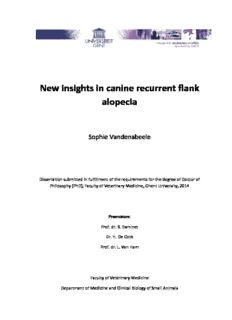
New insights in canine recurrent flank alopecia PDF
Preview New insights in canine recurrent flank alopecia
New insights in canine recurrent flank alopecia Sophie Vandenabeele Dissertation submitted in fulfillment of the requirements for the degree of Doctor of Philosophy (PhD), Faculty of Veterinary Medicine, Ghent University, 2014 Promotors: Prof. dr. S. Daminet Dr. H. De Cock Prof. dr. L. Van Ham Faculty of Veterinary Medicine Department of Medicine and Clinical Biology of Small Animals Printing of this thesis was enabled through the support from: Vandenabeele, Sophie New insights in canine recurrent flank alopecia Ghent university, Faculty of Veterinary Medicine Department of Medicine and Clinical Biology of Small Animals Cover art by Simon, 2014 ISBN 978-90-5894-374-2 Table of contents TABLE OF CONTENTS LIST OF ABBREVIATIONS 5 GENERAL INTRODUCTION 7 1. Introduction 9 2. Hair follicle structure and function 9 3. Hair cycling 11 3.1 Systemic (extrinsic) influences on hair cycling 15 3.2 Intrinsic (local) influences on hair cycling 18 4. Hair follicle cycling disorders 22 5. Canine recurrent flank alopecia 23 5.1 Introduction 23 5.2 Etiology and pathogenesis 23 5.3 Clinical presentation 25 Generalized form 27 Flank alopecia without an episode of visual alopecia 27 Flank alopecia with interface dermatitis 28 5.4 Diagnosis 30 5.5 Clinical management 32 6. Conclusion 33 References 34 SCIENTIFIC AIMS 45 CHAPTER 1 49 Atypical canine recurrent alopecia: a case report CHAPTER 2 63 Immunohistochemical localization of FGF18 in hair follicles of healthy beagle dogs CHAPTER 3 87 Immunohistochemical evaluation of FGF18 in canine recurrent flank alopecia 3 Table of contents CHAPTER 4 111 Study of the behaviour of lesional and non lesional skin of canine recurrent flank alopecia transplanted to athymic nude mice GENERAL DISCUSSION 129 SUMMARY 151 SAMENVATTING 157 CURRICULUM VITAE 163 BIBLIOGRAPHY 167 ACKNOWLEDGEMENT 173 4 List of abbreviations LIST OF ABBREVIATIONS AEC 3-amino-9-ethylcarbazole CRFA canine recurrent flank alopecia DNA deoxyribonucleic acid FGF fibroblast growth factor FGFR fibroblast growth factor receptor GVH graft versus host HE haematoxylin and eosin IHC immunohistochemistry IRS inner root sheath kg kilogram min minute mm millimeter µm micrometer mRNA messenger ribonucleic acid MSH melatonin stimulating hormone PBS phosphate buffered saline POMC pro opiomelanocortin PCR polymerase chain reaction SCID severe combined immunodeficient sec second T4 thyroxine TSH thyroid stimulating hormone Wnt Wingless 5 6 General introduction GENERAL INTRODUCTION 7 8 General introduction 1. Introduction The focus of this thesis is to further characterize canine recurrent flank alopecia (CRFA). First the hair follicle structure and function are briefly reviewed. Secondly the hair follicle cycle and factors influencing hair follicle cycling are described with an emphasis on fibroblast growth factor 18 (FGF18) in order to provide the reader with adequate background information for the scientific studies. Finally a review of the literature regarding CRFA is presented. 2. Hair follicle structure and function The skin is the largest and most visible organ of the body. It forms an anatomic and physiologic barrier between the animal and it’s environment (Miller et al., 2013a). The hair follicle, one of nature’s most fascinating structures, resides in the skin and is a unique mammalian trait (Tobin, 2009). Dogs generally possess a hair coat that covers the entire skin surface, with exception of the nasal planum, footpads, lips, nipples and anus. Hair has many important biological functions, including thermoregulatory, sensory and protective functions (Miller et al., 2013a). Hairs also function in camouflage, social and sexual communication. Hair follicles are usually positioned at a 30-60 degree angle to the skin surface. Although hair length, thickness, density and colour varies between individuals and especially between breeds, all hairs have the same basic structure (Paus et al., 1999). The hair follicle has five major components: dermal hair papilla, hair matrix, hair, inner root sheath and outer root sheath (Figure 1). The hair and inner root sheath are formed by pluripotent stem cells in the hair matrix. The outer root sheath represents a downward extension of the epidermis (Miller et al., 2013a). The anagen hair follicle (growing follicle) is divided in three anatomic segments: the upper portion or infundibulum, the middle portion or isthmus and the lower portion or inferior segment (Figure 1). 9 General introduction The infundibulum consists of the segment from the entrance of the sebaceous duct to the skin surface. The isthmus consists of the segment between the opening of the sebaceous duct and the attachment of the arrector pili muscle. The inferior segment extends from the attachment of the arrector pili muscle to the dermal hair papilla (Miller et al., 2013a). Figure 1. Schematic depicting the five major components from the hair follicle and the three anatomic segments. Adapted from Lloyd and Patel, 2012. In contrast to mice and humans which have single follicles, dogs have compound follicles (Figure 2). In single follicles each infundibulum contains one hair shaft that exits through the os, whereas in compound follicles, multiple hairs exit through one os. A compound follicle in dogs consists of one to five primary hairs surrounded by 5 to 20 smaller secondary hairs. The central primary hair is the largest primary hair and the smaller primary hairs are called lateral primary hairs. Each primary hair arises from its individual pore and has sebaceous glands, sweat glands and an arrector pili muscle. 10
Description: